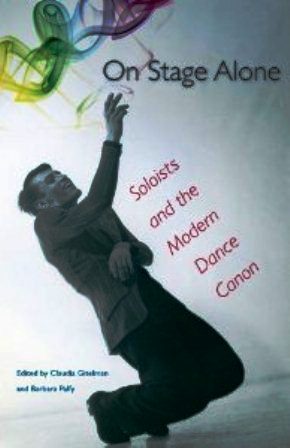I clearly remember the first live performance I saw when the concept of ‘solo dancer’ made a strong impact on me. In the 1980s some time Susanne Linke made a tour of Australia. I remember two works in particular: one, whose name I don’t recall, involved Linke moving slowly and agonisingly across the stage following a strip of bright, white light on the floor. The other was the well-known Im Bade wannen in which Linke danced with, in and around a bath tub. The show was a revelation.

A recent book, On stage alone: soloists and the modern dance canon, recalled my Linke experience and reminded me of the many other solo dancers whose work I have encountered since. After reading the book I was also reminded of the many solo performers whose work I haven’t yet encountered!On stage alone: soloists and the modern dance canon is a collection of essays in which the solo dancer, male and female, is considered for the role he or she may play in shaping culture. Even though there are many acclaimed solo performers who do not appear in the book, to its credit On stage alone is broad in its scope. As Claudia Gitelman notes in her introduction, the book ‘presents an international roster of male and female soloists who worked from the late nineteenth century into the twenty first, and who offer arguments about what it means to be modern’.
We encounter some of the better-known, older exponents of the form. Julie Malnig gives an account of Maud Allan’s exploits, for example, and concludes that ‘In an age of clashing, if not confused, visions of women, Allan’s solo performances marked her as an icon of a newly expressive mode of female sexuality’. And with his usual strong theoretical insight, Ramsay Burt expounds on Vaslav Nijinsky and Mary Wigman and considers the challenging and uncomfortable nature of solo performances given by these two dancers in 1919. ‘Their solos enacted a modernist critique of dominant ideologies of freedom and individuality and, by so doing, stressed a fracture in the symbolic order’, he writes.
But there are also a number of chapters on more recent dancers whose main form of expression is the solo: a chapter on Daniel Nagrin by Deborah Jowitt, for example. Jowitt’s writing has an immediacy that is missing from some of the other essays. She has such a practised eye when it comes to analysing performance and she enables the reader to visualise Nagrin’s dancerly qualities: ‘…his lightest steps were precise in the way they struck the floor, brushed it, or skittered over it. He managed his strength like a tiger, able to move from stillness into an explosion of energy’. Jowitt also strategically places Nagrin within the wider context of modern dance in America, especially within the context of society’s attitudes to the male dancer.
I enjoyed Janice Ross’ essay on Ann Carlson, whose dances with animals I have never seen. Ross made me hanker to do so. Carlson’s performances with a cow or a kitten or a goldfish in a bowl, generate a range of gender and identity issues and contain a wealth of ‘hidden narratives’. Ross examines four works in detail and concludes that Carlson’s solos with animals ‘are tender but compelling reminders of how the act of performing fractures but also reunites us, affording the solitary dancer the possibility of never really dancing alone’.
Other solo performers whose work is highlighted in On stage alone include the Japanese-American Michio Ito, the Brazilian Eros Volúsia and a number of solo artists working in Central Europe in the early part of the twentieth century, including Mata Hari, Olga Desmond and Niddy Impekoven.
The authors address a range of theoretical issues, to which Gitelman alludes briefly in her introduction: gender identity, the notion of the modern body, national and racial differences and others and the book groups essays according to the overarching theoretical and research approach of each. But what I missed in the book was a chapter on the art of solo performance itself, if such an analysis is possible in one chapter. Gitelman’s introduction sums up the content of the book, but it is not an analysis of the form. Nevertheless, On stage alone is a welcome addition to dance literature and opens up the field for further investigation.
Michelle Potter, 3 August 2012
Claudia Gitelman and Barbara Palfy (eds), On stage alone: soloists and the modern dance canon (Gainseville, FL: University Press of Florida, 2012)
Hardback, 213 pp. ISBN 978-0-8130-4025-7
RRP: USD 39.95. Available through many online sites.
2 thoughts on “On stage alone. Claudia Gitelman and Barbara Palfy (eds)”